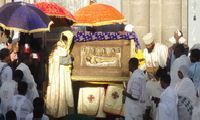Fasika (Ethiopian Easter)
The Orthodox, Catholic, and Protestant Churches throughout the country are celebrating Fasika, or Ethiopian Easter. The calculation of the date follows the computus of the Eastern Christian Churches. The celebration of Fasika is most of the time one week after Easter in the Western Christian Churches. In 2025 the date will be the same for both Churches.
The holy week of Fasika has a somber atmosphere. Church services are not as colorful as on other occasions but for the faithful of great importance. It is the last week of Lent, a 55-day period of fasting. No meat or animal products of any kind, including milk, butter, and eggs are eaten during this time. In the holy week, the faithful do not eat or drink anything before 3 pm. At the churches, there are daily prayers until the break of the fast.

As in the Western Christian Churches Palm Sunday (Hoseana), Good Friday (Siklet), and Easter Sunday (Fasika) are celebrated. On Hoseana the faithful will go to the churches to collect palm leaves to take to their houses. The Hoseana celebrations are especially in Axum very colorful. At the service on Siklet, the faithful will kneel down and rise up 101 times.
The most important service is on the eve of Fasika and is attended by big masses dressed in traditional white clothes. Prayers and chanting continue until the announcement of the resurrection of Jesus Christ in the early hours of the morning. At 3 am everyone returns home to break their fast, slaughtering a chicken at midnight for the symbolic occasion. After a short rest, the celebration of Fasika continues with family and usually includes the slaughtering of a sheep or ox.
